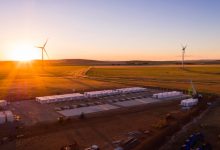The owner of the Hornsdale Power Reserve, which won fame as Australia’s biggest battery under the moniker the “Tesla big battery,” has been fined $900,000 by the federal court after being sued by the Australian Energy Regulator for the failure to deliver promised capacity.
The AER suit against Hornsdale owner Neoen created quiet controversy in Australian energy circles when it was revealed last year, as we wrote in this article: AER sues Hornsdale battery: Fair cop or regulatory over-reach?
As we wrote then, the basic facts of the case against Hornsdale – sized at the time at 100MW/129MWh (it has since been expanded, but also overtaken in terms of size by the Victoria Big Battery) – were not in dispute.
The court documents say that during a firmware upgrade of the Tesla batteries in July, 2019, the “droop settings” on the Hornsdale facility were accidentally changed from 1.7 per cent – the minimum allowed for battery storage to respond at the super-fast speeds advertised – to 3.7 per cent.
It appears that no one noticed this change and it had no impact until October 9, when the 750MW Kogan Creek coal generator in Queensland, the newest and biggest coal unit in the main grid, tripped – for the 17th time over a two year period.
Hornsdale was required to respond under a contract for “contingent frequency response” with AEMO. This is where the cavalry rushes in to address major network problems to prevent outages.
But because of the changed droop response, Hornsdale delivered just 13.4MW in the fraction of the second it had promised, instead of 29MW that would have been expected.
In the end it didn’t matter much, because the lights didn’t go out, and no load was lost. And no one even noticed until Hornsdale owner Neoen later discovered the problem, reported it to the Australian Energy Market Operator , and returned $3.4 million in over-payments.
But to the AER it did matter. It pursued the matter, insisting that software settings are as important as the hardware itself, took it to court and has now won a court order for the owner of the battery to be fined $900,000
AER chair Clare Savage said in a statement the penalty sent an important message to the whole market at a time when many new operators are connecting to the grid.
“It is vital that generators do what they say they can do if we’re going to keep the lights on through our market’s rapid transition to more variable renewable generation,” Savage said.
“It’s what is expected by every household, small and large business across Australia when they pay their electricity bills.
“AEMO relies on accurate information and compliance with offers and dispatch instructions to ensure it can effectively stabilise frequency deviations.”
The action against the Hornsdale battery follows AER actions against various wind farms over the settings in the lead up to South Australia state-wide blackout in late 2016.
Also on Wednesday, AGL was ordered to pay $3.5 million in fines for operating low ride through settings at the Hallett wind farms, which justice Besanko described as a “serious breach of the National Electricity Rules.
It took total penalties against wind farms in South Australia to $6.15 million. Other wind farms to be penalised include the Snowtown 2 wind farm ($1 million), the Hornsdale wind farm (350,000) and the Clements Gap wind farm ($1.1 million.
“More than $6 million in penalties is a significant outcome to make generators take note and ensure they are taking the right measures to support a secure system,” Savage said in a separate system.
“For the whole system to work, accurate information must be provided to the market operator, including the critical LVRT settings.”
Many in the industry wonder why similar action is not taken against coal and gas generators over similar failures, and whether the AER will be taking a similarly strict approach to the actions of thermal generators in the last few chaotic weeks when capacity was withdrawn from the market, or failed to appear.
And some point out, too, the savings that Tesla has delivered – an estimated $150 million in the first two years of operation – when it has intervened in the market, even delivering services it wasn’t paid for, covering up the lack of reliability of the ageing coal and gas generators.
In a statement, Neoen Australia managing director Louis de Sambucy said the judgement was “consistent with submissions jointly made by the AER and HPR to the court in February 2021, where HPR admitted contraventions of three clauses of the NER in relation to a defective firmware upgrade.
“We have co-operated with AEMO and the AER in a transparent and accountable manner throughout the investigation,” de Sambucy said, adding that the non-compliances were accidental, and did not impact system stability.
“Even though the AER has acknowledged that no actual loss or damage occurred due to the events in 2019 in the circumstances as they unfolded, we have since improved our systems, processes and training and have implemented remedial actions to minimise the risk of similar issues arising again.”










